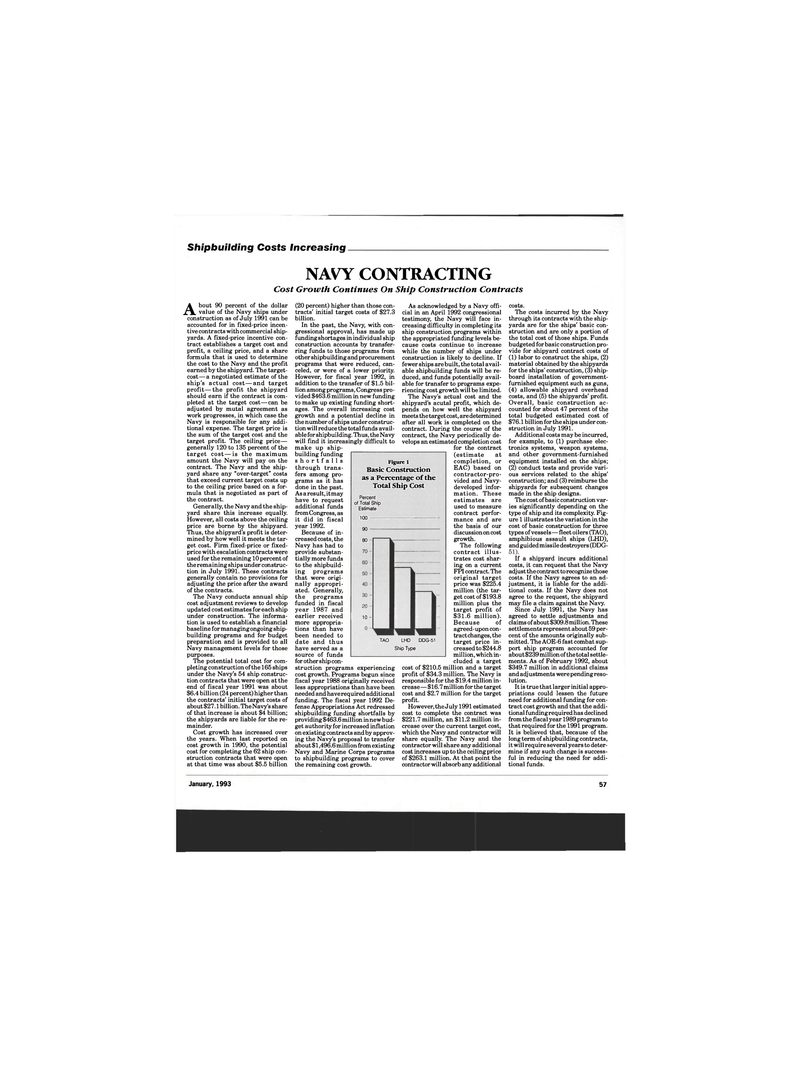
Page 55: of Maritime Reporter Magazine (January 1993)
Read this page in Pdf, Flash or Html5 edition of January 1993 Maritime Reporter Magazine
Shipbuilding Costs Increasing
NAVY CONTRACTING
Cost Growth Continues On Ship Construction Contracts
About 90 percent of the dollar value of the Navy ships under construction as of July 1991 can be accounted for in fixed-price incen- tive contracts with commercial ship- yards. A fixed-price incentive con- tract establishes a target cost and profit, a ceiling price, and a share formula that is used to determine the cost to the Navy and the profit earned by the shipyard. The target- cost— a negotiated estimate of the ship's actual cost—and target profit—the profit the shipyard should earn if the contract is com- pleted at the target cost—can be adjusted by mutal agreement as work progresses, in which case the
Navy is responsible for any addi- tional expense. The target price is the sum of the target cost and the target profit. The ceiling price — generally 120 to 135 percent of the target cost — is the maximum amount the Navy will pay on the contract. The Navy and the ship- yard share any "over-target" costs that exceed current target costs up to the ceiling price based on a for- mula that is negotiated as part of the contract.
Generally, the Navy and the ship- yard share this increase equally.
However, all costs above the ceiling price are borne by the shipyard.
Thus, the shipyard's profit is deter- mined by how well it meets the tar- get cost. Firm fixed-price or fixed- price with escalation contracts were used for the remaining 10 percent of the remaining ships under construc- tion in July 1991. These contracts generally contain no provisions for adjusting the price after the award of the contracts.
The Navy conducts annual ship cost adjustment reviews to develop updated cost estimates for each ship under construction. The informa- tion is used to establish a financial baseline for managing ongoing ship- building programs and for budget preparation and is provided to all
Navy management levels for those purposes.
The potential total cost for com- pleting construction of the 165 ships under the Navy's 54 ship construc- tion contracts that were open at the end of fiscal year 1991 was about $6.4 billion (24 percent) higher than the contracts' initial target costs of about $27.1 billion. The Navy's share of that increase is about $4 billion; the shipyards are liable for the re- mainder.
Cost growth has increased over the years. When last reported on cost growth in 1990, the potential cost for completing the 62 ship con- struction contracts that were open at that time was about $5.5 billion
Figure 1
Basic Construction as a Percentage of the
Total Ship Cost
Percent of Total Ship
Estimate 100 (20 percent) higher than those con- tracts' initial target costs of $27.3 billion.
In the past, the Navy, with con- gressional approval, has made up funding shortages in individual ship construction accounts by transfer- ring funds to those programs from other shipbuilding and procurement programs that were reduced, can- celed, or were of a lower priority.
However, for fiscal year 1992, in addition to the transfer of $1.5 bil- lion among programs, Congress pro- vided $463.6 million in new funding to make up existing funding short- ages. The overall increasing cost growth and a potential decline in the number of ships under construc- tion will reduce the total funds avail- able for shipbuilding. Thus, the Navy will find it increasingly difficult to make up ship- building funding shortfalls through trans- fers among pro- grams as it has done in the past.
As a result, itmay have to request additional funds from Congress, as it did in fiscal year 1992.
Because of in- creased costs, the
Navy has had to provide substan- tially more funds to the shipbuild- ing programs that were origi- nally appropri- ated. Generally, the programs funded in fiscal year 1987 and earlier received 10- more appropria- tions than have been needed to date and thus have served as a source of funds for other ship con- struction programs experiencing cost growth. Programs begun since fiscal year 1988 originally received less appropriations than have been needed and have required additional funding. The fiscal year 1992 De- fense Appropriations Act redressed shipbuilding funding shortfalls by providing $463.6 million in new bud- get authority for increased inflation on existing contracts and by approv- ing the Navy's proposal to transfer about $1,496.6 million from existing
Navy and Marine Corps programs to shipbuilding programs to cover the remaining cost growth. 90- 80
As acknowledged by a Navy offi- cial in an April 1992 congressional testimony, the Navy will face in- creasing difficulty in completing its ship construction programs within the appropriated funding levels be- cause costs continue to increase while the number of ships under construction is likely to decline. If fewer ships are built, the total avail- able shipbuilding funds will be re- duced, and funds potentially avail- able for transfer to programs expe- riencing cost growth will be limited.
The Navy's actual cost and the shipyard's acutal profit, which de- pends on how well the shipyard meets the target cost, are determined after all work is completed on the contract. During the course of the contract, the Navy periodically de- velops an estimated completion cost for the contract (estimate at completion, or
EAC) based on contractor-pro- vided and Navy- developed infor- mation. These estimates are used to measure contract perfor- mance and are the basis of our discussion on cost growth.
The following contract illus- trates cost shar- ing on a current
FPI contract. The original target price was $225.4 million (the tar- get cost of $193.8 million plus the target profit of $31.6 million).
Because of agreed-upon con- tract changes, the target price in- creased to $244.8 million, which in- cluded a target cost of $210.5 million and a target profit of $34.3 million. The Navy is responsible for the $19.4 million in- crease — $16.7 million for the target cost and $2.7 million for the target profit.
However, the July 1991 estimated cost to complete the contract was $221.7 million, an $11.2 million in- crease over the current target cost, which the Navy and contractor will share equally. The Navy and the contractor will share any additional cost increases up to the ceiling price of $263.1 million. At that point the contractor will absorb any additional
TAO LHD DDG-51
Ship Type costs.
The costs incurred by the Navy through its contracts with the ship- yards are for the ships' basic con- struction and are only a portion of the total cost of those ships. Funds budgeted for basic construction pro- vide for shipyard contract costs of (1) labor to construct the ships, (2) material obtained by the shipyards for the ships' construction, (3) ship- board installation of government- furnished equipment such as guns, (4) allowable shipyard overhead costs, and (5) the shipyards' profit.
Overall, basic construction ac- counted for about 47 percent of the total budgeted estimated cost of $76.1 billion for the ships under con- struction in July 1991.
Additional costs may be incurred, for example, to (1) purchase elec- tronics systems, weapon systems, and other government-furnished equipment installed on the ships; (2) conduct tests and provide vari- ous services related to the ships' construction; and (3) reimburse the shipyards for subsequent changes made in the ship designs.
The cost of basic construction var- ies significantly depending on the type of ship and its complexity. Fig- ure 1 illustrates the variation in the cost of basic construction for three types of vessels—fleet oilers (TAO), amphibious assault ships (LHD), and guided missile destroyers (DDG-
If a shipyard incurs additional costs, it can request that the Navy adjust the contract to recognize those costs. If the Navy agrees to an ad- justment, it is liable for the addi- tional costs. If the Navy does not agree to the request, the shipyard may file a claim against the Navy.
Since July 1991, the Navy has agreed to settle adjustments and claims of about $309.8million. These settlements represent about 59 per- cent of the amounts originally sub- mitted. The AOE-6 fast combat sup- port ship program accounted for about $239million of the total settle- ments. As of February 1992, about $349.7 million in additional claims and adjustments were pending reso- lution.
It is true that larger initial appro- priations could lessen the future need for additional funding for con- tract cost growth and that the addi- tional funding required has declined from the fiscal year 1989 program to that required for the 1991 program.
It is believed that, because of the long term of shipbuilding contracts, it will require several years to deter- mine if any such change is success- ful in reducing the need for addi- tional funds.
January, 1993 57

 54
54

 56
56
